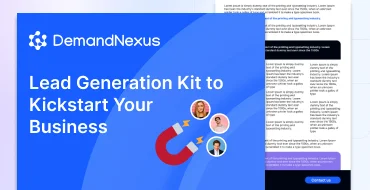In the dynamic world of B2B sales, choosing the right outreach strategy can make or break your lead generation efforts. Email marketing vs cold calling is a perennial debate, with each method offering unique strengths and challenges. Both aim to engage prospects who have no prior relationship with your business, but their approaches differ significantly. As Belkins’ co-founder Michael Maximoff notes, “People’s biases often stem from bad experiences with spam or intrusive calls, but a data-driven approach reveals what truly works.”
DemandNexus bridges this divide by offering integrated solutions that leverage both email marketing and cold calling for maximum impact. This article explores the nuances of each method, their pros and cons, and how DemandNexus can optimize your outreach to drive conversions.
Understanding Cold Outreach
Cold outreach involves contacting potential clients who are unfamiliar with your brand to spark interest and generate leads. It’s a cornerstone of B2B sales, enabling teams to expand their reach, connect with decision-makers, and penetrate new markets. Email marketing and cold calling are two primary channels, each with distinct characteristics.
Why Cold Outreach Matters
Cold outreach fuels sales pipelines by introducing your product or service to new prospects. It’s particularly vital for industries like SaaS and fintech, where building relationships with high-value clients is key. A strategic approach, combining both channels, can accelerate lead generation and shorten sales cycles.
Email Marketing: Scalable and Trackable Outreach
Email marketing, often referred to as cold emailing in this context, involves sending unsolicited emails to prospects to introduce your offerings and prompt a response.
Benefits of Email Marketing
- Scalability: Automation tools allow you to send personalized emails to thousands of prospects simultaneously, as supported by our cold email outreach service.
- Personalization: Tailor messages with prospect-specific data, increasing relevance and engagement.
- Cost-Effectiveness: Lower costs compared to hiring dedicated cold callers, ideal for broad outreach.
- Trackability: Monitor open rates, click-through rates, and responses to optimize campaigns.
- Flexibility: Prospects can respond at their convenience, reducing pressure and boosting reply rates.
Challenges of Email Marketing
- Spam Filters: Emails may land in junk folders if not properly optimized, as Anil Salvi highlights.
- Low Immediate Attention: Prospects receive numerous emails daily, making it hard to stand out.
- Limited for Complex Messaging: Explaining intricate products in a concise email can be challenging.
Boosting Email Marketing Success
To maximize email campaign effectiveness:
- Craft Compelling Subject Lines: Use personalized, curiosity-driven subject lines to increase open rates (40–50% benchmark).
- Keep It Concise: Deliver a clear value proposition in a short, engaging format.
- Include a Strong CTA: Prompt actions like scheduling a demo or replying.
- Follow Up Strategically: Send 2–3 follow-ups with varied messaging to re-engage prospects.
- Use Verified Lists: Ensure accurate, segmented prospect data to improve deliverability.
Cold Calling: Personal and Immediate Engagement
Cold calling involves making unsolicited phone calls to prospects to pitch your product, build rapport, and secure meetings.
Benefits of Cold Calling
- Personal Connection: Real-time, two-way communication fosters trust and rapport, as emphasized in our cold calling services.
- Immediate Feedback: Address objections and gauge interest on the spot.
- Effective for Complex Sales: Explain intricate offerings and answer questions directly.
- Enthusiastic Delivery: Convey passion and energy through tone, enhancing persuasion.
Challenges of Cold Calling
- Intrusiveness: Many prospects find unsolicited calls disruptive, leading to low answer rates (5–20%).
- Resource-Intensive: Requires trained callers, increasing costs and limiting scalability.
- Gatekeeper Barriers: Receptionists often block access to decision-makers.
- Harder to Track: Less detailed metrics compared to email campaigns.
Boosting Cold Calling Success
To improve cold call outcomes:
- Research Prospects: Understand their pain points and tailor your pitch, leveraging our lead research services.
- Start Strong: Open with a question or value-driven statement to capture attention.
- Listen Actively: Adjust your pitch based on vocal cues and responses.
- Follow Up Promptly: Send an email summarizing the call to maintain momentum.
Email Marketing vs Cold Calling: Key Differences
Understanding the distinctions between these channels helps you choose the right approach for your goals. Here’s a comparison:
| Aspect | Email Marketing | Cold Calling |
|---|---|---|
| Scalability | Highly scalable, reaching thousands instantly. | Limited by caller availability and time. |
| Personalization | Highly customizable with data-driven tools. | Personal but relies on real-time adaptability. |
| Engagement | Passive, prospects respond at their leisure. | Active, direct two-way conversation. |
| Cost | Cost-effective, automation reduces labor. | Higher costs for trained callers. |
| Success Metrics | Trackable (open rates: 40–50%, reply rates: 5–10%). | Less trackable (connect rates: 5–20%, appointment rates: 2%). |
Why DemandNexus Is the Best Solution
DemandNexus eliminates the need to choose between email marketing and cold calling by offering an integrated, omnichannel approach tailored to your industry. Our expertise ensures both channels work in harmony to maximize lead generation and conversions. Here’s why we’re the top choice:
- Omnichannel Strategy: We combine cold email outreach and cold calling with LinkedIn and content marketing for seamless prospect engagement.
- Data-Driven Optimization: Real-time analytics track performance across channels, ensuring continuous improvement, as supported by our lead generation services.
- Personalized Campaigns: Custom scripts and emails align with your ICP, boosting response rates in sectors like SaaS and healthcare.
- Expert SDRs: Our trained callers and email specialists deliver high-quality interactions, backed by our outsourced SDR services.
- Compliance Assurance: We adhere to TCPA and CAN-SPAM regulations, protecting your brand reputation.
- Scalable Solutions: From small campaigns to enterprise-level outreach, we adapt to your needs, as seen in our appointment setting services.
DemandNexus’s integrated approach ensures you reach prospects effectively, whether through email or phone, driving measurable results. Book a demo at DemandNexus to see how we can transform your outreach.
Choosing the Right Approach: When to Use Each
The choice between email marketing and cold calling depends on your goals, industry, and target audience.
When to Use Email Marketing
- Large Prospect Lists: Ideal for reaching thousands of leads cost-effectively.
- Simple Offerings: Best for straightforward products that don’t require extensive explanation.
- Global Reach: Effective for prospects across different time zones.
- Initial Outreach: Use emails to introduce your brand and build awareness.
When to Use Cold Calling
- Complex Sales: Suited for high-value, intricate products requiring detailed discussions.
- C-Level Prospects: Direct calls resonate with senior decision-makers in industries like fintech.
- Urgent Responses: When immediate feedback is critical.
- Follow-Up: Engage prospects who’ve shown interest via email but haven’t committed.
Combining Email Marketing and Cold Calling
The most effective B2B sales strategies integrate both channels for a cohesive omnichannel approach. Alex Sribnyi from Belkins suggests, “Start with email to build awareness, then use calling to nurture engaged leads.”
How to Combine Both
- Start with Email: Send a personalized email introducing your solution, followed by nurturing content like case studies.
- Follow Up with Calls: Call prospects who opened or clicked emails to discuss their needs and schedule meetings.
- Use Behavioral Data: Target calls to prospects showing high email engagement, as supported by our lead nurturing service.
- Nurture with Content: Send emails with valuable resources between calls to maintain interest.
Example: For a SaaS client, DemandNexus sent an initial email campaign achieving 45% open rates, followed by targeted calls to engaged prospects, resulting in a 15% appointment booking rate.
Tools to Enhance Cold Outreach
Technology streamlines both email marketing and cold calling, improving efficiency and tracking. DemandNexus integrates these tools into our services:
- HubSpot: Tracks email performance and call outcomes, enhancing campaign insights.
- Outreach.io: Automates email sequences and call scheduling for seamless outreach.
- SalesLoft: Provides analytics and automation for both channels, optimizing SDR performance.
Best Practices for Email Marketing and Cold Calling
To maximize results, follow these best practices:
For Email Marketing
- Time Emails Strategically: Send during mid-morning or early afternoon for higher open rates.
- Segment Lists: Target specific buyer personas for relevance.
- A/B Test: Experiment with subject lines and CTAs to optimize performance.
For Cold Calling
- Call at Optimal Times: Late afternoons or end-of-week slots often yield better connect rates.
- Prepare for Gatekeepers: Use referral-based scripts to bypass barriers.
- Record Calls: Analyze conversations to refine pitches.
Conclusion: Email Marketing vs Cold Calling—Why Choose?
The debate over email marketing vs cold calling misses the bigger picture: both are powerful when used strategically. Email marketing excels in scalability and trackability, while cold calling delivers personal, high-impact engagement. By integrating both, as DemandNexus does, you can cast a wide net and build deep connections, driving leads through your sales funnel. Whether targeting healthcare or IT, our omnichannel approach ensures your outreach is effective and efficient.
Ready to optimize your B2B outreach? Visit DemandNexus to book a demo and discover how we can blend email marketing and cold calling for unparalleled results.
FAQs
What’s the main difference between email marketing and cold calling?
Email marketing involves sending unsolicited emails, offering scalability and trackability, while cold calling is a direct phone conversation, providing personal engagement.
Which is more effective?
Effectiveness depends on your goals. Email marketing suits broad outreach; cold calling excels for complex sales and senior prospects.
Can both be used together?
Yes, combining email for initial outreach and calls for follow-ups maximizes engagement, as DemandNexus’s strategies demonstrate.
What tools support cold outreach?
HubSpot, Outreach.io, and SalesLoft streamline email and call campaigns with automation and analytics.
When’s the best time to cold call?
Late afternoons or end-of-week periods typically yield higher connect rates.
Related Resources



